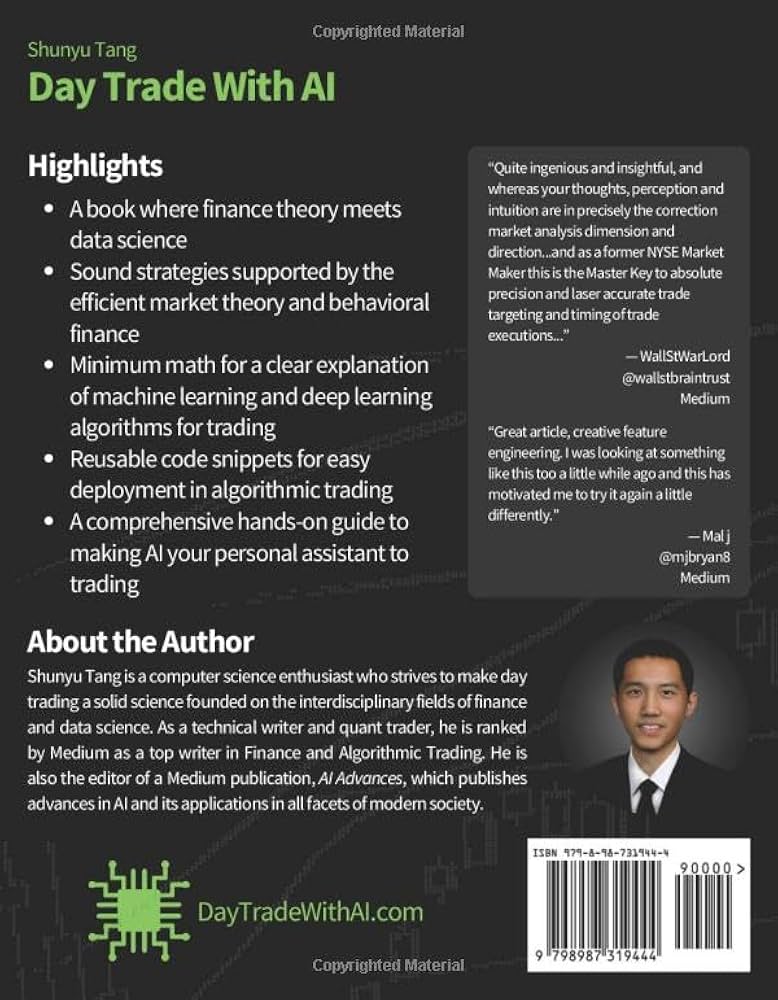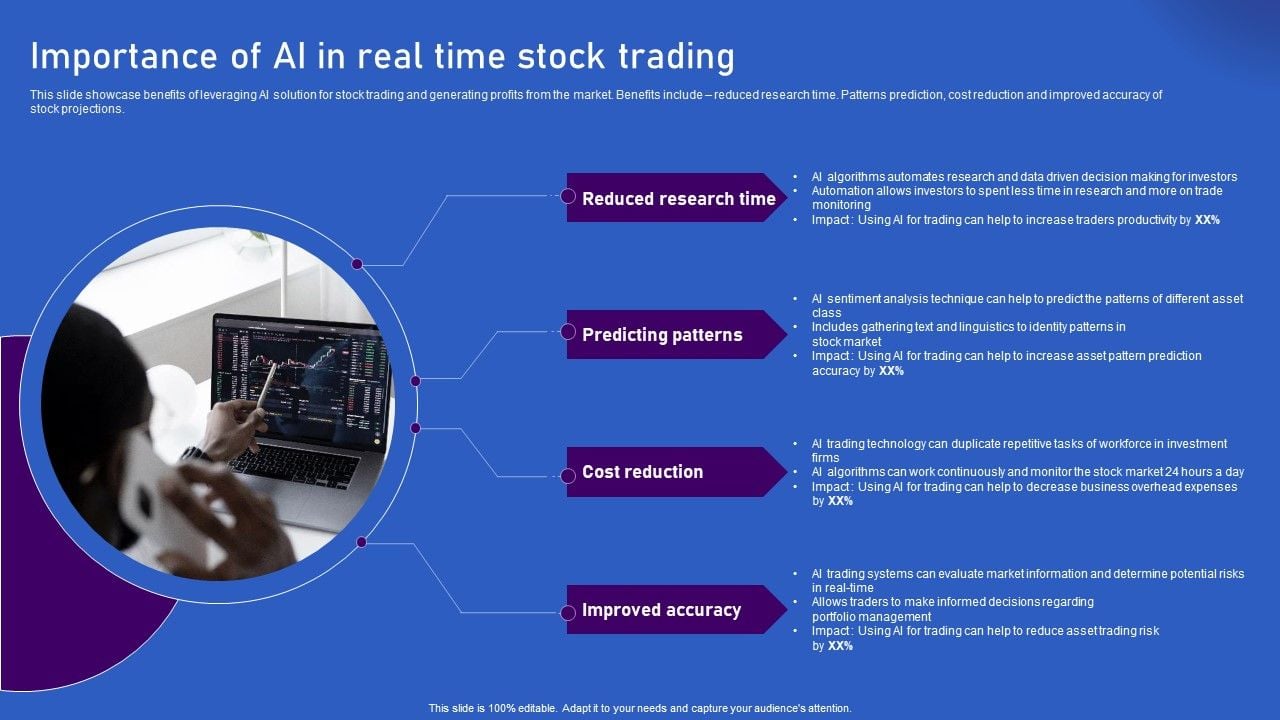Did you know that some traders believe their lucky socks can influence market outcomes? While they might be cozy, leveraging AI in day trading is a far more effective strategy. This article explores the best practices for using AI in day trading, highlighting key benefits like improved decision accuracy and enhanced market trend analysis. We’ll discuss effective AI tools, common algorithms, and how AI can reduce trading risks. Additionally, we’ll cover selecting the right AI platform, essential data for analysis, and the ethical considerations involved. With insights from DayTradingBusiness, you'll learn how to incorporate AI into your strategy and backtest your approaches, all while managing costs and ensuring data security. Get ready to elevate your trading game!
What are the key benefits of using AI in day trading?
AI improves day trading by analyzing vast market data instantly, spotting patterns humans miss. It helps automate trades for faster execution and reduced emotional bias. AI-powered tools provide real-time alerts, enhancing decision timing. It adapts to market changes quickly, offering a competitive edge. Overall, AI increases efficiency, accuracy, and consistency in day trading strategies.
How can AI improve trade decision accuracy?
AI improves trade decision accuracy by analyzing vast data quickly, identifying patterns, and predicting market trends with high precision. It uses machine learning to adapt to changing conditions, reducing emotional bias. Combining AI with technical analysis tools enhances timing for buy or sell signals. Incorporating real-time news sentiment analysis helps anticipate market moves. Consistently updating AI models with new data ensures better accuracy in fast-paced day trading environments.
What AI tools are most effective for day trading?
The most effective AI tools for day trading include algorithmic trading platforms like MetaTrader with AI plugins, predictive analytics tools such as Trade Ideas, and machine learning models like QuantConnect. These tools analyze market data in real-time, identify patterns, and automate trades based on predictive signals. Using AI for backtesting strategies and risk management with platforms like Tradestation or NinjaTrader also boosts effectiveness. Combining these tools with solid market knowledge enhances day trading success.
How does AI help with market trend analysis?
AI analyzes vast market data quickly, identifying patterns and predicting price movements. It processes real-time news, social media, and financial reports to spot emerging trends early. Machine learning models adapt to changing market conditions, improving accuracy. AI-driven tools automate technical analysis, enabling faster decision-making. Overall, AI enhances insight into market trends, helping day traders make informed, timely trades.
Can AI reduce risks in day trading?
Yes, AI can reduce risks in day trading by providing real-time data analysis, identifying patterns, and automating trades based on predefined strategies. It helps traders react faster to market changes and minimizes emotional decisions. Using AI alongside solid risk management, like setting stop-loss orders, improves overall safety in day trading.
What are common AI algorithms used in trading?
Common AI algorithms in trading include machine learning models like random forests, support vector machines, neural networks, and reinforcement learning. These algorithms analyze market data, identify patterns, and make predictions about asset movements. Deep learning, especially with time-series data, is also popular for forecasting stock prices.
How do I select the right AI trading platform?
Choose an AI trading platform with proven accuracy, real-time data, and customizable algorithms. Prioritize platforms with user-friendly interfaces and transparent performance records. Test the system with demo accounts before risking real money. Ensure it offers risk management tools like stop-loss orders. Look for platforms with good customer support and regular updates. Compatibility with your trading style and assets is crucial.
What data should AI models analyze for day trading?

AI models should analyze real-time market data, including price charts, volume, bid-ask spreads, and order book data. They need historical price trends, technical indicators like moving averages, RSI, and MACD. Incorporate news sentiment, social media feeds, and economic indicators affecting the market. Also, monitor macroeconomic data, earnings reports, and geopolitical events for context. Using diverse data sources helps AI develop accurate, timely trading signals.
How can AI assist with real-time market monitoring?

AI helps with real-time market monitoring by analyzing live data feeds, detecting patterns, and alerting traders to sudden price movements or trends. It automates data collection from multiple sources like news, social media, and financial reports, providing instant insights. AI-powered algorithms can identify trading signals faster than humans, enabling quick decision-making. Using machine learning models, traders can predict short-term market shifts, reducing reaction times. Integrating AI tools with trading platforms ensures continuous, real-time surveillance of market conditions, improving responsiveness and accuracy.
What are the limitations of AI in day trading?
AI in day trading struggles with unpredictable market swings, sudden news impacts, and black swan events. It can misinterpret data during volatile periods, leading to wrong trades. AI models rely on historical data, so they may fail to foresee unprecedented market shifts. Overfitting to past patterns reduces adaptability to real-time changes. There's also the risk of algorithmic errors or unforeseen bugs causing losses. Human oversight remains essential to catch AI blind spots and adjust strategies quickly.
How do I incorporate AI into my trading strategy?
Use AI to analyze market data and identify patterns faster than humans. Integrate AI-powered tools like predictive algorithms and real-time analytics into your trading platform. Test AI models thoroughly with historical data before relying on them live. Combine AI insights with your own judgment to avoid overdependence. Continuously monitor and fine-tune AI systems based on market changes. Use machine learning to adapt strategies to evolving trends. Automate routine trades with AI to free up time for strategic decisions. Stay updated on AI developments to leverage new capabilities for day trading.
Learn about How to Incorporate Position Sizing into Your Trading Plan
What ethical considerations exist when using AI in trading?
Using AI in day trading raises ethical issues like market manipulation, data privacy, and transparency. Traders must ensure AI systems don’t manipulate markets or exploit insider information. Respect for data privacy means handling client data responsibly and avoiding misuse. Transparency requires clearly disclosing AI use to clients and stakeholders. Avoiding bias in algorithms is crucial to prevent unfair advantages or market distortions. Responsible AI use also involves monitoring for unintended consequences and maintaining accountability.
How can I backtest AI-driven trading strategies?
Use historical market data to simulate your AI-driven trading strategies. Backtest by running your AI model on past price movements to evaluate performance. Validate with out-of-sample data to avoid overfitting. Incorporate transaction costs and slippage to reflect real trading conditions. Analyze metrics like profit factor, drawdowns, and win rate to assess viability. Regularly update your backtests as market conditions change.
What are the costs associated with AI trading tools?
AI trading tools typically cost between $20 to $200+ monthly, depending on features and provider. Some platforms charge one-time setup fees or extra for premium signals. Advanced AI systems with real-time data and customization can cost thousands annually. Additionally, there might be costs for data feeds, API access, or subscription to third-party services. Always factor in the expense of ongoing updates, maintenance, and potential training to maximize AI trading effectiveness.
How do I ensure AI models stay accurate over time?

Regularly update training data with recent market data. Monitor model performance and adjust parameters as needed. Incorporate feedback from actual trading results. Use ongoing validation to catch drifts in accuracy. Keep models aligned with current market trends and news.
What skills do I need to implement AI in day trading?
You need strong programming skills, especially in Python, data analysis, machine learning, and understanding trading algorithms. Knowledge of financial markets and technical analysis is essential to interpret AI insights effectively. Familiarity with AI tools like neural networks, natural language processing, and backtesting platforms helps optimize trading strategies. Analytical thinking, risk management, and the ability to interpret AI-generated data are also crucial.
How do I manage AI system failures or errors?
Monitor AI outputs constantly, set up alerts for anomalies, and have manual override options. Regularly update and train the AI with new data to prevent errors. Maintain clear risk management strategies, including stop-loss orders. Document failures to identify patterns and improve system reliability. Always verify critical decisions with human judgment.
What are the best practices for data security in AI trading?
Use encrypted connections for data transmission, store data securely with strong access controls, and regularly update security protocols. Limit access to sensitive trading data, monitor systems for unusual activity, and implement multi-factor authentication. Ensure AI models are trained on secure, anonymized data to prevent leaks. Conduct regular security audits and stay updated on cybersecurity threats.
How can AI help with emotional trading biases?
AI can identify emotional trading biases like impulsiveness and overconfidence by analyzing your trading patterns and sentiment data. It provides objective insights, alerts you to emotional decisions, and automates disciplined strategies, helping you stick to logical choices instead of reacting emotionally.
Conclusion about What Are the Best Practices for Using AI in Day Trading?
Incorporating AI into day trading can significantly enhance decision-making, improve accuracy, and reduce risks. By leveraging the right tools and algorithms, traders can analyze market trends more effectively and monitor real-time data, ultimately leading to more informed trades. However, it's essential to remain aware of AI's limitations and ethical considerations. For traders looking to integrate these advanced technologies, understanding the necessary skills and maintaining data security are crucial. With the right approach, AI can be a powerful ally in achieving trading success, making resources like DayTradingBusiness invaluable for navigating this evolving landscape.
Learn about Best Practices for Using Day Trading Software